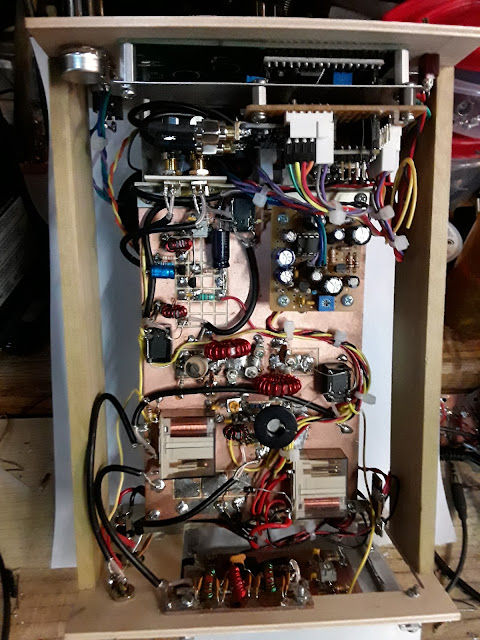As a follow on to yesterday's post here is a radio built out of wood. Well, the front, back and side panels are hobby craft wood, but the rest is hardware.
I used to have a stash of small aluminum panels but when that dried up, I tested the use of thin gauge plywood available from JOANN Fabrics. This project was a test of that concept.

20X4 Juliano Blue LCD
This radio uses two crystal filters one for LSB and the other for USB. As such the BFO is at 9 MHz and the filter center frequencies of the filters are spaced above and below the BFO. Don't get excited -- if you ever owned a Drake TR-3 or TR-4 this is SOP.
The only metal I had was a piece big enough to house one 4X6 piece of PCB board. This led to stacking two boards using 1 inch aluminum spacers between the boards. What can't be seen in the photos is the second board which houses the IF Module and ADE-1 Mixers along with the switchable two crystal filters.
At one time a company in Israel was selling a surplus board with three KVG filters: USB/LSB and AM all for $33 on eBay. That was source for the SSB filters.
The KVG filters are often seen in W7ZOI projects like the 20M SSB QRP transceiver of 12/89 - 1/90 in QST.
The back apron presented some special problems as wood is not a good heat conductor and is an insulator. Thus, a large rectangular hole was cut in the wood panel and a heat sink installed using small "L" brackets. The front and back wood panels are mounted to the aluminum base plate using aluminum 1/2-inch angle stock.
Check out how thin the plywood is.
Initial Wiring of the Rig
Observe the lower left corner where the microphone jack is installed. That hole is 3/8 inch in diameter and too close to the edges. This would eventually fail. So, the engineering solution was two small aluminum plates that were installed behind the hole and in front of the hole. This was like a sandwich cast and problem solved. Thin Plywood is cool but can be very fragile.
A medium dark wood stain would have been the lipstick on the pig but looks cool in the naked mode.
Friend N2CQR often use the wooden craft boxes available from Michaels for enclosures so I am not plowing new ground. My approach uses an aluminum base which insures a solid ground plane and foundation for the wood panels and wood side braces. Speaking of the sides they are 1X1/4 inch and 10 inches long. Small brass wood screws affix the side braces to the front and back panels.
Of note the digital electronics are mounted vertically using the 20X4 LCD mounting holes. We also spaced things so my Fat Fingers could operate the controls with a good grip on the main tuning knob.
Just a test of a concept and it appears thin plywood is a suitable substitute for metal or PCB panels.
Keep on soldering!
73's
Pete N6QW



